Accounting for taste
Expert reviewers
Essentials
- There are five basic tastes that humans can perceive: sweet, sour, salty, bitter and umami.
- Our tastebuds do most of the heavy lifting when it comes to how we taste food, but there are other factors, like a food’s smell, texture and structure.
- There are both physiological differences (how many tastebuds we have) and genetic variations that can affect how we perceive taste.
- Foods can be designed and manipulated during manufacture to provide the optimum nutritional content, physical properties and taste.
As the global population continues to expand, more and more pressure will be placed on our food production and distribution systems. We’re going to need more efficient and productive agricultural output, greater equity in distribution and significant reduction in food loss to feed the 9.7 billion people that are expected to live on Earth by 2050.
The manufacture of food in the lab, jam-packed with all our nutritional needs, is one way to help ease the burden on our agricultural systems. But does this mean we’re looking at some sort of soylent-fuelled future where we consume substances that meet our nutritional needs but fail to provide the pleasure of a crisp juicy apple, or the sweetness of a mango, or the satisfaction of a burger with chips?
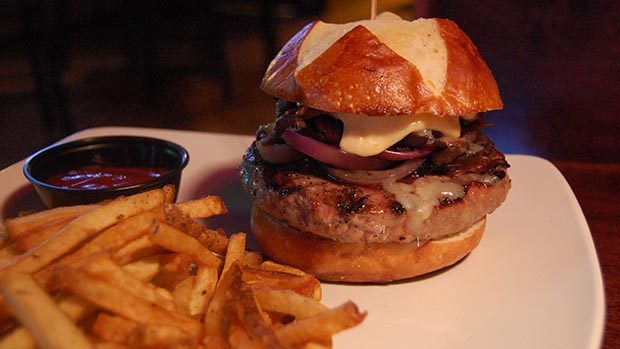
What if we could have the best of both worlds—super-healthy, nutritionally balanced food that also tasted great? Let’s check out how this might just be possible. First, though, we need to explore our sense of taste, and how it works.
What we taste
Here's a quick look at the five basic tastes that humans perceive. Although there’s an almost limitless array of flavours found throughout the cuisines of the world, they are all variations and combinations of just five basic tastes.
Sweet
This is a big one. The first food most of us consume as a baby—breastmilk—is high in lactose, which is a sugar. So we’re primed from our early days to enjoy sweet, sugary tastes. Some proteins and alcohol molecules can also elicit a response from our sweet receptors.
Chemicals responsible: sucrose, lactose, fructose, some alcohols, some proteins, chemicals in artificial sweeteners like aspartame and stevioside and many more!
Sour
It is generally acidic foods and drinks that we classify as sour. As too much extra acid isn’t healthy for our digestive system, we’re hardwired to react to this taste and limit our intake of it.
Chemicals responsible: hydrogen ions (H+).
Salty
This is an easy one—we’ve all made the mistake of putting too much salt on our chips, or experienced that dreadful mouthful of tea when we realise that someone has put salt, not sugar, in the sugar bowl. However, in the right amounts, we like the taste of salt and it leads us to seek out protein-rich foods. We also need it because it helps our cells to maintain their pressure and function.
Chemicals responsible: sodium chloride (NaCl) is common table salt, but other salts, like magnesium or potassium, can also taste salty.
Bitter
Just as we’re hardwired to like sweet things, this is a taste we’re hardwired to reject. Evolutionarily speaking, bitter flavours generally came hand-in-hand with toxic, poisonous substances, so we had to learn to not eat them. We have learned to enjoy some bitter tastes, however, such as coffee and beer. Many vegetables also contain bitter compounds.
Chemicals responsible: alkaloid and polyphenol substances, and there are several! And, just as there are several chemicals that elicit a bitter taste, there are around 35 different proteins that are activated by our taste receptors when interacting with these chemicals.
Umami/savoury
This taste has only been included in the group of ‘core’ tastes relatively recently. It’s that delicious flavour of a meat broth, or the ‘moreish’ flavour of foods that are high in MSG (monosodium glutamate, C5H8NO4Na). It’s a common flavour in many Asian cuisines, found in soy sauce and meat, but also in ripe tomatoes, cheese and asparagus.
Chemicals responsible: amino acids—glutamic acid (C5H9NO4) and its close cousin aspartic acid (C4H7NO4).
Scientists are currently trying to figure out if there are other specific tastes that should be included in this list, such as calcium, or fatty substances.
How we taste
For this, we need to largely thank our tongues. The tongue is an organ, and a pretty weird-looking one, when it comes down to it. It’s made up of eight muscles interwoven together, which gives it its flexibility—essential when trying to wrap it around a slippery ice-cream or get that annoying bit of pistachio out of your back teeth!
The surface of our tongue is covered with tiny bumps which, when looked at under a microscope, are actually pointy. They’re called papillae, and they contain our tastebuds and also some glands that help in the creation and secretion of saliva. There are three different types of papillae, of different shapes and sizes. They’re found in different regions of our tongue in varying numbers. What they all have in common though, is the tastebuds they contain.
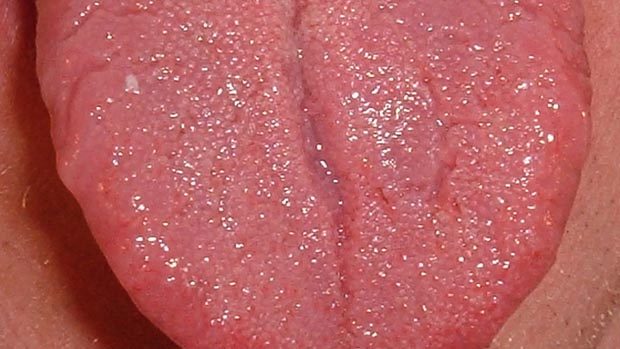
Tastebuds are made from a combination of cells—basal cells, columnar cells (these are structural cells) and between 10 and 50 taste receptor cells. These have tiny hair-like structures called microvilli, which are basically nerve-endings that interact with the chemicals from our food. This interaction activates a protein, which in turn causes other messenger chemicals to be created. These activate more nerve cells that send messages to our brain about what we’re eating—delicious chocolate, perhaps, or an extremely fishy anchovy. The receptor cells are renewed every 9–10 days.
The number of tastebuds people have can vary greatly. The average adult has between 2,000 and 8,000 tastebuds, but some people have larger, and fewer, tastebuds while others have many more smaller tastebuds.
While our tastebuds, in their various papillae, are clustered in particular regions of our tongues, despite what many of us may have been taught in school, it’s not actually true there are certain areas of the tongue responsible for particular taste sensations. However, there are different types of taste receptors, that are each activated by a different suite of chemicals to elicit the various taste sensations we perceive. A taste cell only has one type of receptor, but each tastebud contains a combination of cells that express each type of receptor.
The taste receptors for sweet, bitter, sour and umami are actually proteins (produced and coded for by particular genes in our DNA) that are found on the surface of the cells. They are activated when they sense the presence of particular chemicals, triggering the sequence of cascade reactions and message sending described above. The salt receptor is called the epithelial sodium (Na) channel (ENaC), which is essential a membrane that allows for the transport of sodium ions to certain cells in our body.
There are thought to be specific taste receptors corresponding to the five main types of taste humans can perceive:
- sweet: a combination of the T1R2 and T1R3 proteins
- bitter: the various T2R proteins—there are around 25 of these
- sour: the PKD2L1 protein
- umami: a combination of the T1R1 and T1R3 proteins
- salty: possibly ENaC, epithelial sodium channels
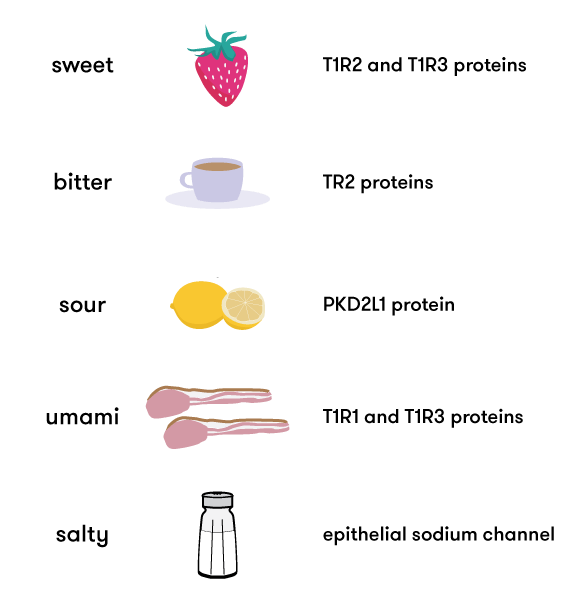
But it’s not only the taste sensation on our tongues—there are also taste receptors found in our throat and in our gut, though these act in a slightly different way to those on our tongue. The way a food smells is also important to our overall eating experience. As we chew, volatile compounds are released and travel from the back of our mouths to our noses, where they stimulate our olfactory system. Without this, much of the flavour of the food we’re eating (as opposed to simply taste, which is perceived purely by our tastebuds) is lost. For example, the flavour of vanilla is entirely dependent upon its aroma—it has no actual taste, but we perceive the flavour when its aroma hits our nose.
There other sensations besides taste that take place in our mouths. These too, are driven by the activation of receptors triggered by certain chemicals in the food we eat. The TRP-V1 protein is activated by heat—a mouthful of hot soup, perhaps, but also by capsaicin (hot chillies), piperine (black pepper) and allyl isothiocynanate (hot mustard). The TRPM8 protein is triggered when we eat cold foods, like ice cream, and it’s also responsible for the cold feeling we get when we eat foods with menthol, mint or eucalyptus in them.
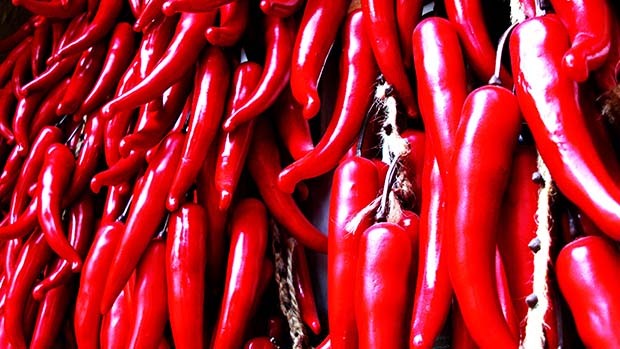
The texture and consistency of the food—how it feels in our mouths—is also important to how we perceive its taste, and whether or not we like it. Scientists have spent a lot of time investigating the rheology (the way liquid matter flows) and tribology (how oils and fats lubricate both the food and our mouths as we eat) to understand how these factors affect peoples’ food preferences.
Why we taste
Differentiating between useful nutritious food and poison is the main driver for our sense of taste. Our strong (and usually negative) response to bitter flavours is primarily to enable us to avoid eating poisonous foods—hence the large number of taste receptors we’ve developed as a response to the broad variety of poisonous (to us) plants that exist in the environment we once foraged in and relied upon almost entirely for our daily nutrition.

Similarly, our love of sugar comes from a fundamental need for energy and we need proteins to provide the amino acids essential for growth and tissue replenishment. Neither of these nutrients were as readily available back in the early days of human evolution as they are to us today.
My taste isn’t your taste
We all have our favourite foods, be they chocolate, ice cream, cherries or stinky cheese, and most of the time, the reason we like (or love) it, is because of its taste—that little thrill our tastebuds send up to the pleasure receptors in our brains. But if we all have the same basic tastebuds, and our tastebuds and the messages they send to our brains are fundamentally controlled by a series of chemical reactions, then why don't we all like (and hate) the same foods and flavours?
Well, it’s partly genetic. All those taste receptors are coded for by particular genes, so slight variations in our DNA can affect how and what we’re able to taste. There’s only one gene that codes for the sweet receptors, but there are several variants of this gene that impact upon different people’s sensitivities to sweetness. There are several genes for all the bitter receptors, and how many of these we all have can vary from person to person. Other genetic variations exist that affect peoples’ sense of smell, which is also important for taste.
Texture is also crucial—we all know someone that doesn’t like mango because they don’t like the ‘feel’ of it in their mouths. The sliminess of okra can make others recoil. There is an entire science built up on the chemistry and physics of taste and the act of eating, known as oral processing. This examines the way the bulk structures of food impact upon our sensations of taste, how they break down in our mouths, and how the residues they leave behind can affect our next mouthful.
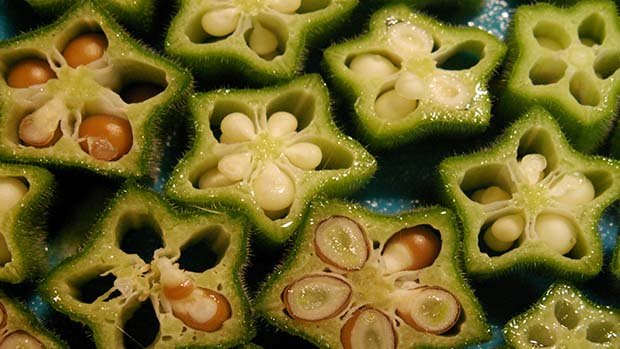
And those foods you really hate, and can never imagine getting to like? Apparently a huge component of our food/flavour/taste preferences are learned, and based on previous experience. Research has shown that it only takes around 10–15 tries of a food to ‘learn’ to like it. Or at least not hate it. So gentle persistence is indeed the key for parents of picky eaters!
Designer foods
So this brings us to our idea of lab-designed and manufactured foods. At this stage, the scientists working on these don’t really envisage a future where all we eat originates from a petri dish rather than a field—the goal is to develop nutritional complements to an otherwise ‘normal’ diet based around dietary guidelines: processed foods that are quick and convenient, but also healthy and nutritious (unlike the majority of ultra-processed foods we so happily consume today).
Another major goal is to provide healthy and palatable foods to people who have trouble consuming normal foods—such as those who suffer from dysphagia, which is a difficulty with swallowing. Often these people have no other option but to eat meal after meal of pureed, mushy foods. One option that researchers are working on to provide these people with a better option uses high-pressure processed meat. The high-pressure treatment tenderises the meat and makes it safer for swallowing. It also preserves more of the nutritional value. Researchers are also working on cheeses made from milk where the size of the fat droplets have been regulated. This alters its texture, making it softer and easier to eat. So these products have the initial sensations and palatability of ‘normal’ meat or cheese, but are in fact softer, and will break down much more easily and self-lubricate to allow for easier and safer swallowing.
Creating options low in saturated fats is another area of research. Low-fat options need to replicate the lingering sensation that a fatty emulsion leaves in our mouths or, chances are, people will reject it as a substitute.
Another aspect of designer foods is the fortification of foods with useful nutrients that a population might not receive from their everyday diets. In Australia, there are two examples of mandatory fortification—we have thiamin and folic acid added to our wheat flour that’s used for making bread. This helps provide the nutrients a pregnant woman requires to prevent neural tube defects in her developing baby. We also have iodine added to all our table salt, to help prevent iodine deficiencies that can lead to thyroid problems and cretinism.
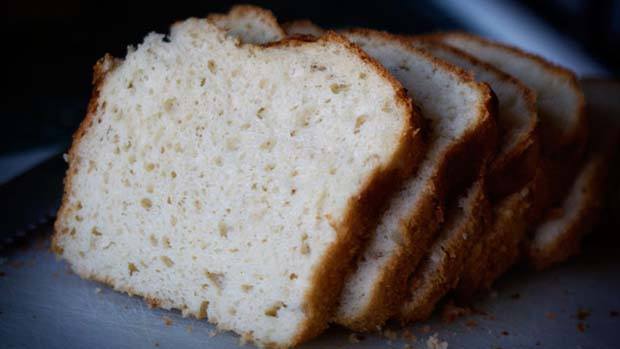
Some designer food can also be used to fight malnutrition. Food scientists in South Africa have developed a biscuit made from sorghum and cowpeas (crops that are endemic to the region and easy to grow there) that provide 50 per cent of a child’s daily protein requirements. While the recipe for this biscuit was developed and fine-tuned in the lab, it’s easy to make and can be cooked by anyone. You can find the recipe here. In a similar project in India, biscuits high in protein, vitamins, antioxidants and other nutrients have been developed by incorporating the ‘super food’ Spirulina, a type of green algae. The World Food Programme have also developed a number of fortified and energy and protein-dense foodstuffs for use in disaster areas and emergency food relief.
So it appears that there are, in fact, a number of factors that can account for our personal tastes. And as we go into the future, scientists, and some food companies, will keep working on pandering to those tastes, to develop healthier and more nutritious food that can complement our agricultural systems and also create foods that will provide nutritional options for people who might otherwise struggle to maintain a healthy diet.





